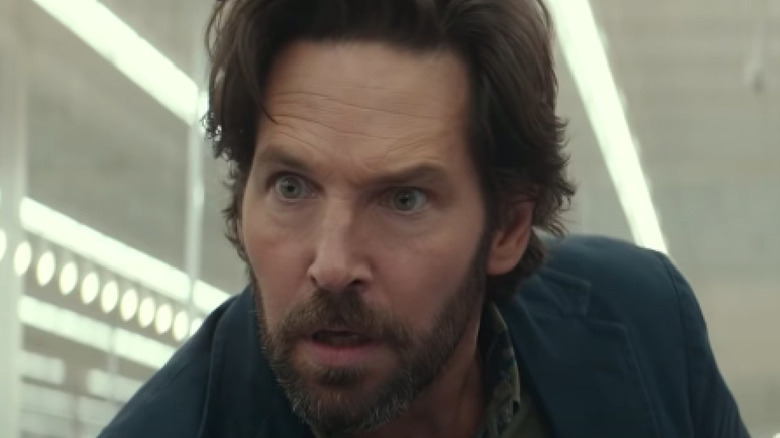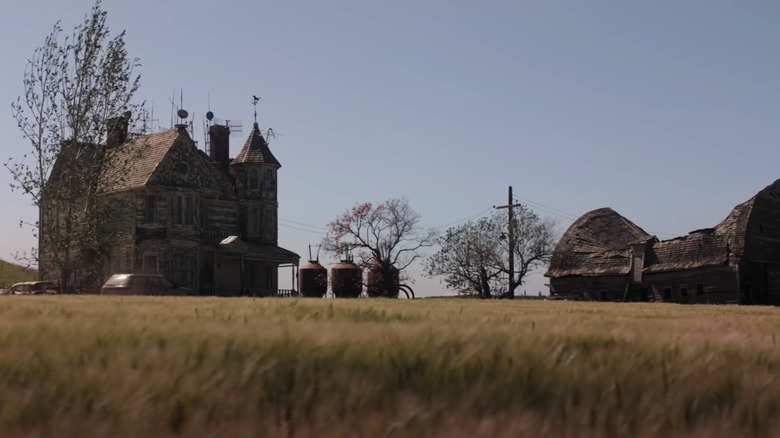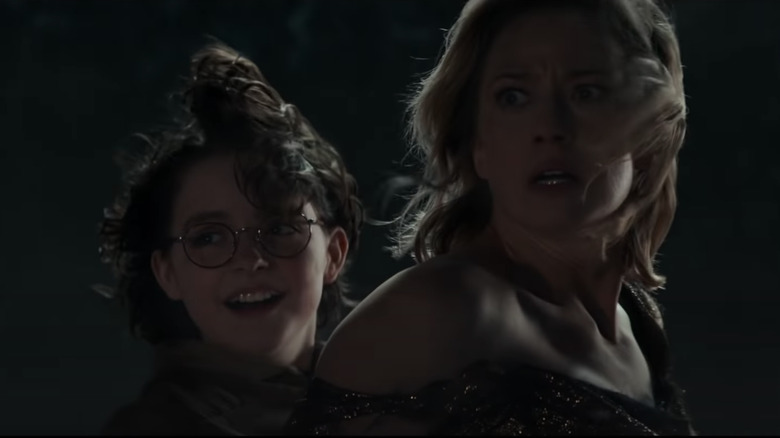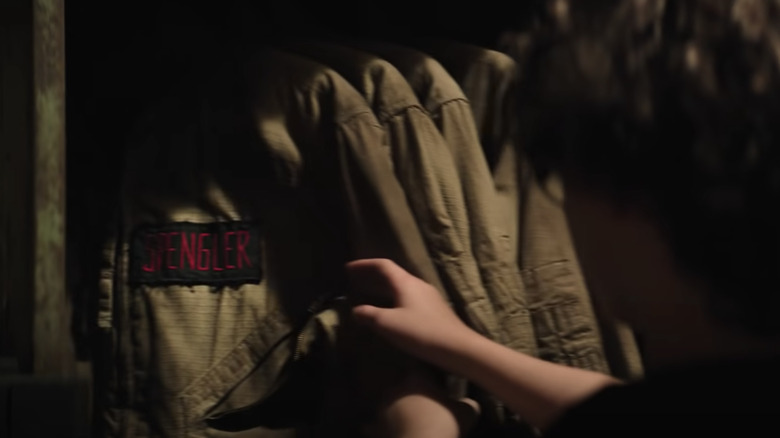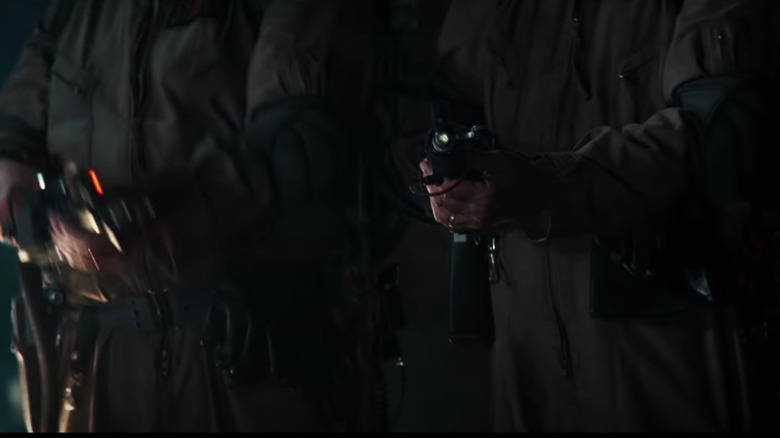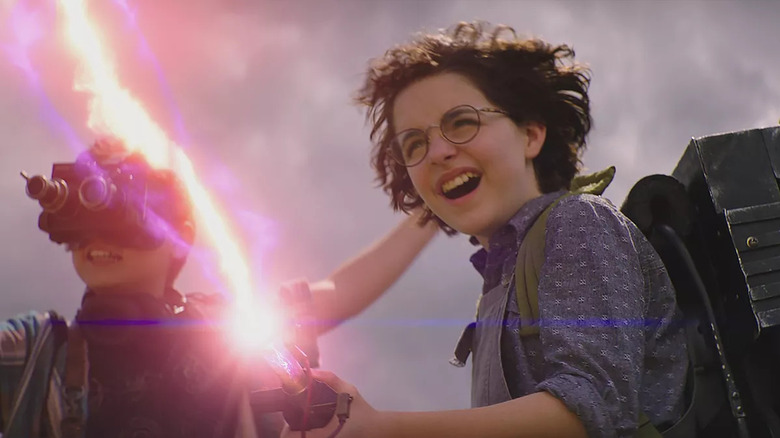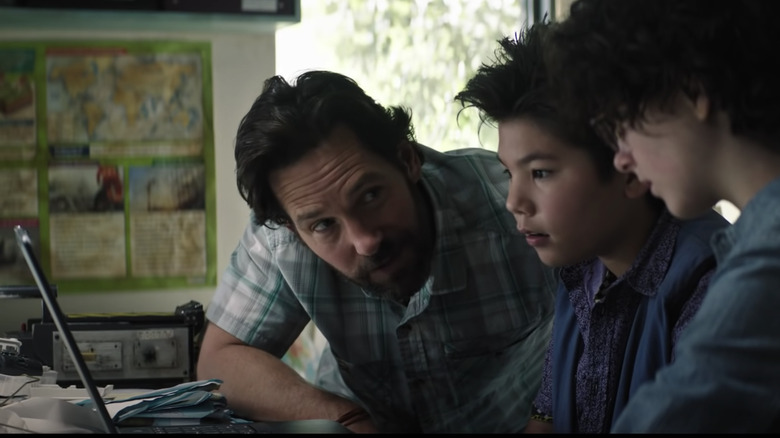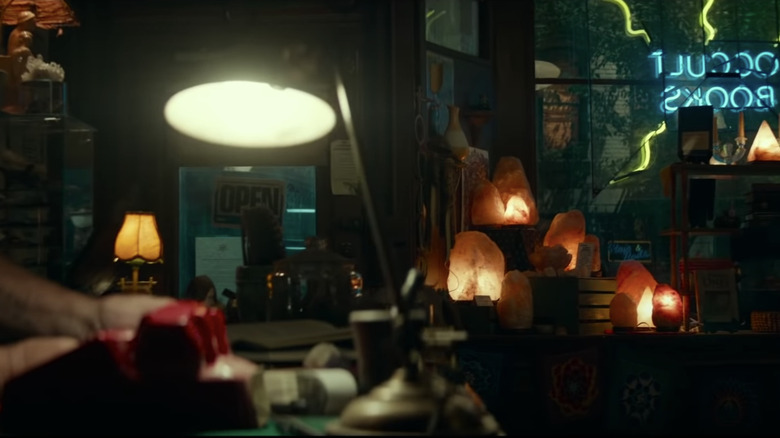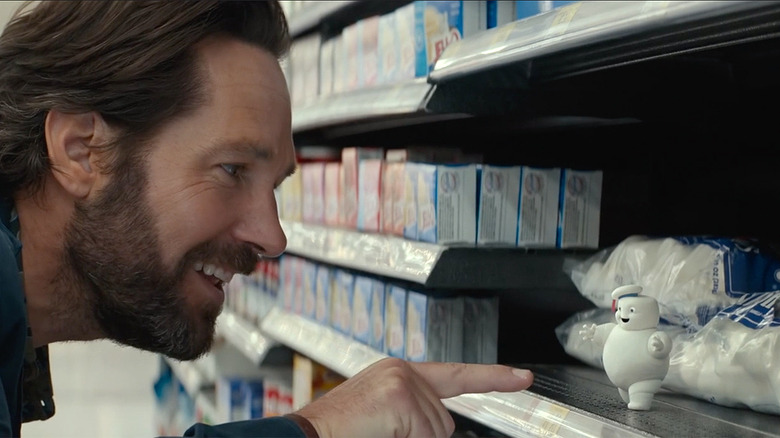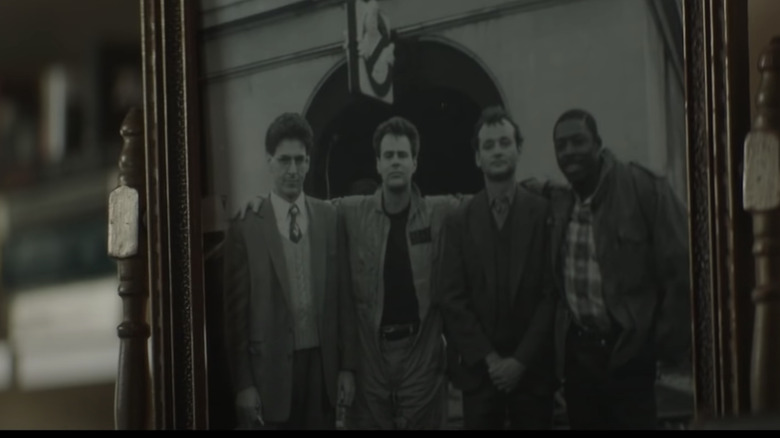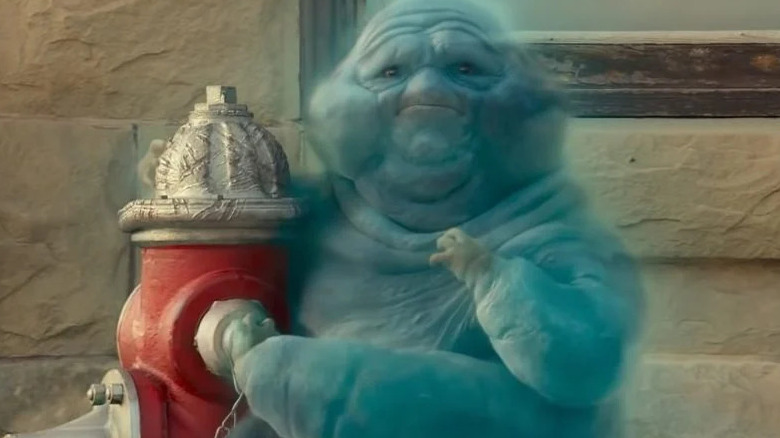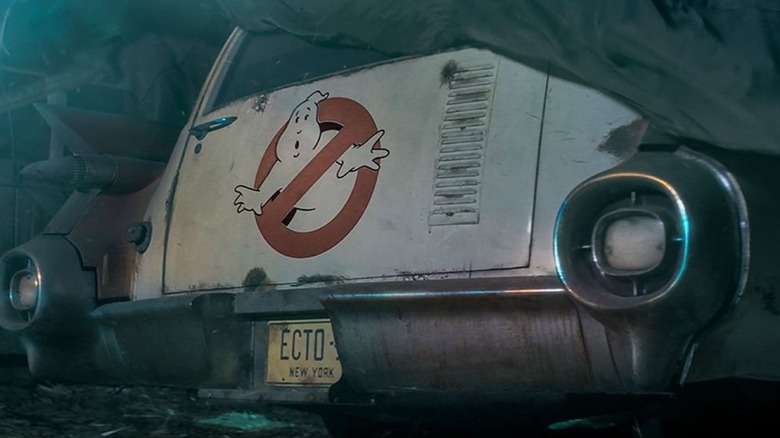Easter Eggs You Missed In Ghostbusters: Afterlife
We may receive a commission on purchases made from links.
Depending on where and how you choose to see "Ghostbusters: Afterlife," you may be greeted by a pre-show video message from writer/director Jason Reitman, as critics were at pre-release screenings. "If you're a 'Ghostbusters' fan," says the Oscar-nominated "Juno" filmmaker (and son of Ivan Reitman, director of the 1984 classic), "you're about to go on the greatest Easter egg hunt of your life."
It's no empty promise. Love it or otherwise, "Afterlife" is crammed with so many visual cues, not-so-hidden props, word-for-word quotations and even music cues referencing the original film that it almost feels at times like you are watching the original film. But, when something so fully evokes the feelings and memories of one of the greatest action/comedies ever made, how could that be a bad thing?
Well, Mr. Reitman, consider the challenge accepted. With Easter basket in hand, let's venture into every spooky, silly, unapologetically reverential frame of "Ghostbusters: Afterlife" to hunt for eggs. Read on for explanations of all the big ones — but first, repeat after us: I ain't afraid of no spoilers.
Getting biblical
Although "Afterlife" rarely concerns itself explicitly with 1989's "Ghostbusters II" (which writer/director Jason Reitman has said is canon in this storyline), at one point Paul Rudd's teacher character Gary Grooberson refers to "New York in the '80s" as being "like the Walking Dead," and adds: "there hasn't been a ghost sighting in 30 years." Later, when Mckenna Grace's Phoebe (granddaughter of the late Harold Ramis' character Egon Spengler) speaks on the phone with Ray Stantz (Dan Aykroyd), Ray makes it clear that the ghostbusting business went belly-up sometime in the '90s — essentially, "Ghostbusters" and "Ghostbusters II" happened, and everything else is forgotten. We're told that in the years since, Bill Murray's Venkman went back to university and Ernie Hudson's Winston is a successful finance businessman; Ray, as we can see, is still running his occult bookstore — and he says "Egon Spengler can rot in hell."
As it turns out, Egon spent the last thirty years of his life somewhere awfully close to it. Spengler split on the other Ghostbusters (and his family, including daughter Calle, played by Carrie Coon), took all their equipment and moved to middle-of-nowhere Summerville, Oklahoma. There, he essentially lived as a hermit and spent the rest of his days hunting ghosts and suppressing uprisings.
With Egon dead, and his daughter in Summerville to clean up his life with kids Phoebe and Trevor (Finn Wolfhard) in tow, the three discover a real mess: Egon lived in a dilapidated house, the locals mockingly called him "the dirt farmer," and he died deeply in debt. He also seems to have been obsessed with Revelation 6:12, as he has excerpts and references to the bible verse spray painted around the grounds.
Further tying the old friends together, when Phoebe calls Ray, you may have noticed the former Ghostbuster is sporting a new tattoo on his arm. That tattoo on Stantz says ... you guessed it ... Revelation 6:12.
"And I beheld when he had opened the sixth seal, and, lo, there was a great earthquake," reads that verse in the King James bible. "And the sun became black as sackcloth of hair, and the moon became as blood."
In most movies, this could be called "foreshadowing." But if there's such a thing as "backwards-shadowing," this might qualify, because the verse clearly calls back to the day of judgment on Stantz's mind in the original film when Venkman told the mayor that New York was headed towards a disaster of biblical proportions.
"What he means is Old Testament, Mr. Mayor, real wrath of God-type stuff ... fire and brimstone coming down from the skies! Rivers and seas boiling!" Of course, there's also a scene in the original "Ghostbusters" where Ray recites the bible verse to Winston — but he accidentally quotes it as Revelation 7:12. It's a good thing Ray didn't get that tattoo back in 1984, or he'd be mistakenly walking around with a very different verse on his arm.
Lining Up
There are, at a minimum, four key moments where characters either paraphrase or repeat key lines verbatim from 1984's "Ghostbusters." Each of them not only ties these Ghostbusters back to the original, but also provides some context for key scenes in the new movie.
You likely either laughed out loud or groaned out loud at the most noticeable one. It occurs when Trevor, Phoebe and her friend Podcast (Logan Kim) are arrested after destroying half on Main Street via proton pack blasts. We learn that Trevor's crush Lucky (Celeste O'Connor) is the daughter of the local sheriff (Bokeem Woodbine), who has put them in jail. When Phoebe requests her phone call, the sheriff answers as though he's been listening to a lot of SiriusXM's '80s on 8: "Who ya gonna call?" The call of course, goes to Ray Stantz, effectively calling in the troops.
Another key moment occurs as Gozer is nearing a return, needing a new "Gatekeeper" and "Keymaster" to open the gate between dimensions. After we see Callie attacked in her father's hidden basement lab, the kids come home to find her zoned out and disheveled, sitting in a chair and looking quite similar to Sigourney Weaver when she first got possessed in the original movie. If you remember that scene, you'll be delighted by Carrie Coon's haunting response when they approach and refer to her as mom. "There is no mom," the new Gatekeeper replies. "There is only Zuul."
When Phoebe puts on her proton pack for the first time, she asks Podcast to "Switch me on." It's a small touch, but evocative of a phrase employed by the original crew, typically indicating to the audience that it's time to bust some ghosts.
Lastly, in a much less showy moment but possibly the sweetest of these lines, Annie Potts makes her return as the delightful Janine Melnitz. In the original film, there were numerous instances where Janine answered the Ghostbusters' phones with a deceptively simple phrase that conveyed both an eagerness to please and at the same time a jaded, New Yorker attitude of perturbed impatience. It feels only appropriate, then, that when Callie and her kids walk into Egon's old house and start poking around, she appears out of nowhere and says dryly: "Can I help you?"
A few more, fairly-random notes on the topic of memorable lines and Easter eggs: When Phoebe and Podcast are testing the proton pack, he says they are in "Rust City," which was the not-so-secret title the film used to conceal its identity during production. In "Ghostbusters II," Egon said that when he was a child he had "a Slinky, but I straightened it"; if you look on Phoebe's nightstand when the character is first introduced and living in her old home in Chicago, you can see a straightened Slinky toy.
Egon's new old digs
As we observe the home that Egon died in recently, the dilapidated residence screams a few things: eccentric genius, ghost hunter and dude who lived alone, most significantly. But, like anyone of retiree age, there are lots of references to his old job — and an unwillingness to let it go.
The equipment is most obvious. Egon's grandkids find a (occupied) ghost trap buried in the floor, a P.K.E. meter in the main home, and a proton pack and the old Ecto-1 vehicle also on the grounds. Beyond that, we see odd stacks of books arranged similar to what the Ghostbusters found when they had their first ghost encounter at New York City Public Library. As Venkman once said: No human being would stack books like this.
In Egon's lab, there are also numerous references to his '80s NYC heyday. To enter, for instance, you have to slide down a fireman's pole much like the one Ray once treasured. Under some lights, we see what looks to be the "spores, molds and fungus" collection that Egon awkwardly employed as a pick-up line (and has become something of a meme in the years since), and then we see a closet filled with old Ghostbusters uniforms.
When the kids put on the uniforms, we know they scribble their own names where the nametag typically goes (what we don't know, however, is how Egon's old suits fit 12-year-old kids so perfectly). When Phoebe explores her granddad's pockets, they find evidence that Egon hasn't emptied them in some time. In addition to a pair of his old glasses, they discover a Nestle Crunch wrapper — referencing a long-discussed random moment at the beginning of the original "Ghostbusters" where Venkman says "you've earned this" and hands Egon the candy bar. In the years since, fans have probably devoted way too much effort into discussing the reasoning behind the moment — but honestly, it was probably just Bill Murray making a half-hearted attempt at fulfilling a product placement obligation.
In the kitchen of the farmhouse, you might be able to spot the "man-eating toaster" from "Ghostbusters II." The kids later discover a very old looking Twinkie in the glovebox of the Ecto-1. This is undoubtedly a reference to Egon's "Big Twinkie" speech from the original film. It's not the same Twinkie — it's unwrapped in the old movie, and we see Egon take a bite — but as Winston would undoubtedly say, that's an old Twinkie.
Relationship mysteries
Although "Afterlife" concerns itself with three generations and plenty of characters, certain matters of the heart seem to be conveniently omitted, while others are merely alluded to. Most noticeable, perhaps, is the super-sweet Egon/Janine relationship we all loved from the original film (she had essentially moved on to the Rick Moranis character by the sequel). In "Afterlife," the Annie Potts character introduces herself by saying "I was your father's ... we were ... friends."
It's reasonable to assume that their fan-favorite relationship fizzled out, as the Ghostbusters business did the same. It's also reasonable to assume that when Egon and Janine began flirting with each other, Callie was already born (in real life, actress Carrie Coon is 40 years old). So, while none of this is canon, one could draw the conclusion that Egon had already been married and divorced before the events of the original "Ghostbusters" film, which provides some interesting new shading to his character.
On the other hand, Callie never discusses her mother, and Coon could certainly pass for someone a few years younger. Could it be that in an "Afterlife" sequel, Janine would reveal that she is Callie's birth mother? That could be tricky, considering that the baby would most likely be born between "Ghostbusters" and "Ghostbusters II" (Jason Reitman has said that Coon's character was born between the two original "Ghostbusters" films) but if some screenwriter is smart enough to figure it out, remember you heard it here first.
On much more firm footing, the mid-credits scene delightfully comes after the credits list Sigourney Weaver, who has at that point not yet appeared in the film. When the screen lights up, we see the "Aliens" series star (who apparently has not aged a day) sitting at a table opposite Venkman, playing the old psychic card game test that Peter once utilized to hit on college co-eds. The pair seem playful and extremely comfortable with each other; it's the sort of movie chemistry that only works when you put two personalities together and they click, and it's a key element Weaver and Murray brought to the first two "Ghostbusters" films.
It's also, perhaps, the dynamic you might expect from an old married couple. Although it isn't clearly stated, you can see a ring on the Ghostbusters' finger (see pic above). Taken together, these clues would seem to indicate that Peter Venkman PhD eventually settled down and put a wedding ring on the cello-plucking finger of Dana Barrett. Now, that would have been a fun wedding reception to attend.
Musical encore
When Podcast first begins recording Phoebe for his show, you might have felt a sudden twinge of nostalgia. That's because the background score being played for the scene — and heard several other times in the film — is a none-too-subtle callback to Elmer Bernstein's original music.
It's called "Lab Partners," and although it is a new composition from Rob Simonsen, the score's whimsical elements offer a much-needed break from the spookiness that, in retrospect, makes you appreciate what Bernstein did for the original "Ghostbusters" all the more.
"To reflect the idea of passing the torch from old Ghostbusters to new, from Ivan Reitman to his son Jason," Simonsen said in a press release discussing his "Afterlife" contributions," "we integrated and reimagined Elmer Bernstein's classic original score into something for a new generation."
Simonsen's track "Mini-Pufts" similarly has callbacks to the original score — and to make matters even more cool, Simonsen even brought in some of the original musicians (and instruments!) featured on the Bernstein score.
"The cue 'Mini-Pufts' was one of the most fun cues to write. Cute little terrorizers that have no conscience," Simonsen explained. "We used a synth sound from the legendary DX7 synthesizer, used in the original. We also used a lot of twinkling percussion and of course the ondes martenot, performed by Cynthia Millar who played it on the original '84 score."
Also, fun fact: star Mckenna Grace sings the song that plays over the credits. It's called "Haunted House," and is the debut single from the Emmy-nominated actress, who signed last year to Photo Finish records. Grace has been increasingly involved in the music world, having appeared in the music video for the 2020 Blackbear song "Queen of Broken Hearts."
Far easier to spot is the always-welcomed "Ghostbusters" theme song, as performed by Ray Parker Jr. (and of course, Huey Lewis before him) and arriving at the very end of the film. Looking back on the music video all these years later, the sight of celebrity cameos, Parker as a faded ghost and the four Ghostbusting legends dancing through Times Square is something that deserves its own remake — but please, this time no Missy Elliot.
Don't sleep on Ivo
The name "Ivo Shandor" might not mean much to most folks heading into "Afterlife," but by the end of the film it will. As briefly discussed in the original "Ghostbusters" film, Shandor was a cultist who designed the 550 Central Park West building that eventually became ground zero for the Gozer invasion. By employing certain materials in the building's construction, he made it conducive to spectral inhabitation — and in the years since Ivan Reitman's films, Shandor's backstory has been significantly expanded by media like 2009's "Ghostbusters: The Video Game" (which Aykroyd and Ramis both had a hand in writing, and all four Ghostbusters gave their images and likenesses).
References in "Afterlife" begin with the name of the new ground zero in Summerville. In the first scene of the film, you can see Egon's car crashing through gates that read "Shandor Mining Co., Est. 1927," an entrance that can be glimpsed several other times as well. Later, Phoebe and Podcast examine a facade to the mine that "showed up without explanation," seemingly depicting Gozer, Zuul and Vinz Clortho, the Keymaster. The film mentions at least twice that this mine is where Shandor gathered materials to build the cold riveted girders with cores of pure selenium for the 550 Central Park West building, which he constructed as a super-conductive antenna that would be the ideal supernatural portal to our realm.
When the new generation of Ghostbusters begins exploring the mine, one of the things they find down there is the corpse of Ivo Shandor, lying in state in a glass coffin. Podcast finds this endlessly creepy — but even more so when it becomes clear that Shandor is being resurrected alongside his beloved Gozer the Gozerian.
If you blink you'll miss it, but Ivo's brief return to life features a cameo by an Oscar-winning actor who is nearly unrecognizable. Yup, that's JK Simmons (a good luck charm for Jason Reitman, having appeared in nearly every film the director has made going back to 2005's "Thank You for Smoking"). In the scene, he is heavily make-upped, has scraggly hair, and seems to be affecting some sort of voice — but Ivo has just enough time to profess an eagerness to rule alongside Gozer before the shape-shifting god of destruction so rudely rips him in half.
Ghostbusters on YouTube
When it becomes apparent that Phoebe and Trevor have some research to do on the grandfather they never met, they go precisely where any modern teenager would: the card catalog at their local library. Just kidding — of course, it's YouTube.
For starters, teacher/seismologist Mr. Grooberson shows them clips of the so-called "Manhattan ghost stories" he explains to them when he first sees the ghost trap. Later, Phoebe goes on YouTube again to watch the old Ghostbusters commercial. While all that footage is glimpsed in the 1984 "Ghostbusters" movie, the film cleverly re-purposes it as historical artifact.
This is particularly effective because the climactic street scenes at the end of the original "Ghostbusters" effectively captured the chaos of the gathering crowd, as well as a shoot that feels unplanned; looking back now, it seems like news footage. The commercial, meanwhile, was (and is) particularly funny because Murray, Aykroyd and Ramis are acting like inexperienced public speakers conveying the awkward line readings and none-too-subtle attempts to hit their marks that you might have seen in an '80s low-budget local commercial. For both of these blessings, Jason Reitman can thank his dad (who serves as a producer and was reportedly on set nearly every day).
Oh, and the phone number in that old commercial? In "Afterlife," Phoebe calls it and gets Ray Stantz. In real life, calling 555–2368 (or any 555 number) will just get you a "your call cannot be completed" message.
De Niro diss
In one of the film's more random comments, when Ray Stantz answers his red phone and starts running through the events of the last thirty years to catch up Egon's granddaughter, he references a movie star as having contributed to the downfall of the Ghostbusters. When he drops the line, you can imagine Robert De Niro innocently sitting in the theater, getting all offended and screaming at the screen: "You talkin' about me?"
During the exposition dump, Stantz remarks that "Some actor bought up most of Tribeca, and we lost the firehouse."
This most certainly refers to De Niro, who founded TriBeCa productions in 1989 (just when things would have begun going south for the Ghostbusters) with partner Jane Rosenthal. Together, they have since organized the annual Tribeca Film Festival, and De Niro also opened the restaurant Tribeca Grill in 1990. The "Taxi Driver" legend has also at various points had a stake in Tribeca's Greenwich Hotel, the Tribeca Cinemas, and as of 2018 his "business empire" was worth an estimated $1 billion dollars.
Although Aykroyd and De Niro have never appeared in a film together, the line feels like an ad-lib lovingly teasing a fellow actor's good fortune in business — and perhaps, how much that firehouse property would be worth today if the Ghostbusters had held onto it.
One additional sidenote: see that red phone above in Ray's bookstore? Writer/Director Jason Reitman says it's an Easter egg tribute to the phone Janine uses (in some incarnations) at Ghostbusters HQ.
Nice doggy!
The scene in and around Gary Grooberson's trip to Walmart is a plethora of Easter eggs and callbacks, many referencing the adventures of Louis Tully. While the somewhat, mostly-retired Rick Moranis is pretty much the only "Ghostbusters" star not to come back for "Afterlife," the film essentially turns Paul Rudd's character into a modern-day equivalent (if a wee bit sexier).
In Walmart, Grooberson has a normal scene in public turn into a horrifying moment of isolation — reminiscent of Tully's experience at the Tavern on the Green. First he spots tiny marshmallow men coming to life (the so-called "Mini-Pufts"), adorable at first and then turning into Gremlins-like creatures who take pleasure in turning each other into s'mores. Then he stumbles upon Vinz Clortho, the demigod Tully thought was a dog — appropriately enough, with its head buried in a bag of dog food.
Like Louis Tully, Grooberson is cornered and transformed into the Keymaster. Another great touch is in the scenes where Grooberson is possessed — Rudd is undoubtedly running with the same unmistakable, goofy gait that Moranis employed in the original film.
A few more things: Sharp-eyed fans will spot the kids curiously observing the colander helmet Egon put on Tully (Podcast wears it for a little bit), and they might also notice an ad for Stay-Puft marshmallows painted on the side of a Main Street building the kids go past when they free the Ecto-1 from its jail impounding, driving in front of the image as the sirens blast.
Reunited and it feels so good
As much fun as it is watch the new generation busting ghosts, let's be honest: The film's money moment is seeing the original four Ghostbusters (okay, three and a CG-powered recreation of Harold Ramis as a ghost) once again battling Gozer. The entire scene is packed with references to the classic showdown on the rooftop of 550 Central Park West, with some Easter eggs easier to spot than others.
Perhaps the funniest is after Ray tries once again to make Gozer (voiced this time, as a matter of fact, by Oscar nominee Shohreh Aghdashloo) vacate the premises by identifying himself as a representative of local law enforcement. The Gozerian replies: "Are you a god?"
Of course, in the original film, Ray answers "no," resulting in the group nearly being killed by a blast from its fingertips. "Ray," Winston screamed at him in the first film, "when someone asks you if you're a god, you say yes!"
In "Afterlife," Ray looks to his partners for help with the question. "Come on Ray," Venkman shoots at him, and this time he answers in the affirmative.
Also paralleling the earlier scene, there are reminiscent phrases like "toast" and "light 'em up," but perhaps Venkman's best line comes from a new one-liner only Bill Murray could deliver so effectively: "Okay boys, on the count of 3, go on 2."
Ghosted
Some might say there aren't enough ghosts in "Afterlife," but many of those you do see have fun, built-in Eggs of their own.
Most prominent is "Muncher," who is undoubtedly in the spirit of sloppy, ravenous, John Belushi-inspired "Slimer" from the other movies (and eventually, a quasi-sidekick for the Ghostbusters in various media). Like Slimer, Muncher is constantly chowing down — but on metal objects, which he can then spit chunks of, Gatling gun-style, at his enemies. The ghost is "voiced" (or perhaps more accurately, "noised") by Josh Gad. If you're a real "Ghostbusters" nerd, you might appreciate the ghost as a reference to the "Back in the Saddle" episode from 1997's "Extreme Ghostbusters" cartoon series. The series is very hard to locate these days, but this upload in Spanish might give you an idea of the episode's plot, which had the original team pairing up with some new Ghostbusters to stop Slimer-like ghosts who similarly ate metal.
Incidentally: This is the first "Ghostbusters" film to not have a Slimer appearance. Jason Reitman has said that he wanted ghosts who would be "native to the actual area" in Oklahoma, implying perhaps that Slimer is still hanging out back in the Big Apple.
As the mine shaft ghosts break free and flood the surrounding area in "Afterlife," you can briefly spot a zombie-looking ghost drinking coffee in the coffee shop. Most likely, this specter is some sort of reference to similar-looking taxi ghost in the original "Ghostbusters."
Finally (and perhaps most amusingly), sharp-eyed viewers will recall a briefly-glimpsed ghost with a projectile eye, who also appears as Summerville is overrun. This ghost is an updating of the "Bug-Eye Ghost," which began life as a Kenner toy from the "Real Ghostbusters" cartoon show in 1987.
What's next?
The final big Easter eggs in "Afterlife" might be planting seeds to pay off in other "Ghostbusters" movies, rather than this one. By the end of the film, it seems like Callie and the kids might relocate to NYC and continue their ghostbusting efforts where it all began. This effort will be funded by none other than Winston Zeddemore, who the franchise seems to be setting up as a Bruce Wayne-like benefactor who will gladly throw an endless amount of money behind re-establishing the Ghostbusters.
Be sure to stay in your seat and watch until the end of the credits. Then you'll see Janine and Winston meeting and discussing the future of the Ghostbusters. We see Winston re-purchasing the old firehouse, bringing the Ecto-1 home, and we even get a glimpse of a blinking red light on the dusty old containment unit. Worth noting: the red status light traditionally indicates that there's a ghost in the unit. Could Slimer be in there?
"I want to be an example of what's possible," Winston tells Janine, perhaps with an eye on what's to come. "I may be a businessman, but I will always be a ghostbuster."
